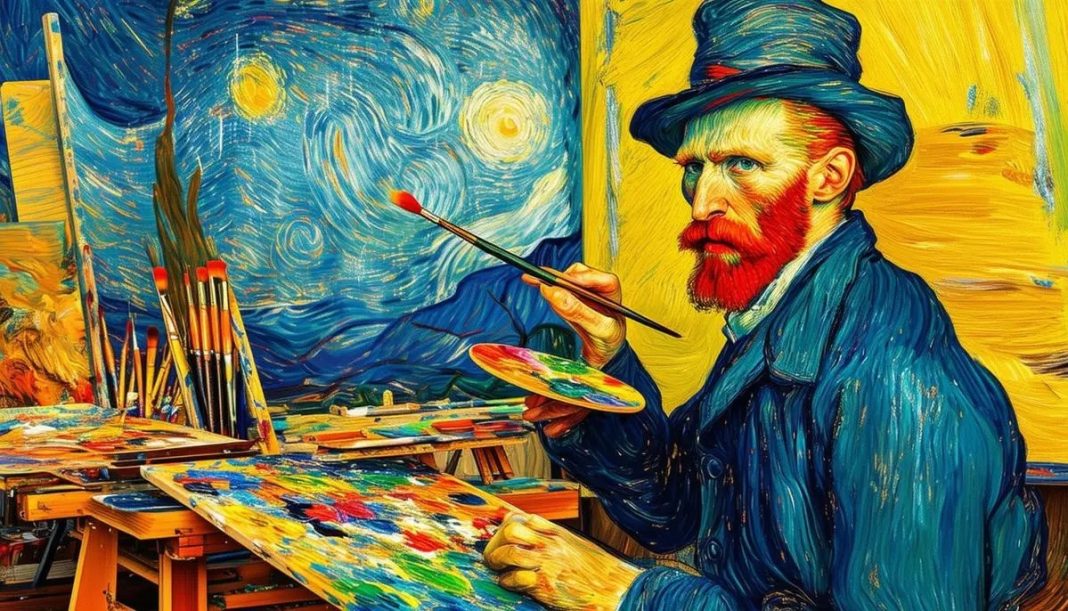Vincent van Gogh, one of history’s most influential artists, underwent a dramatic evolution in his painting style throughout his short yet prolific career. His journey from dark, moody beginnings to vivid, expressive masterpieces showcases a profound transformation influenced by his personal struggles, evolving techniques, and exposure to different art movements. This article delves into the key periods of Van Gogh’s artistic evolution, highlighting notable works that mark the shifts in his technique and color palette, illustrating how his distinctive style came to be.
The Early Years: Dark Beginnings in The Netherlands (1881-1885)
Van Gogh’s early works were deeply influenced by his time in the Netherlands, where he focused on capturing the harsh realities of rural life. His paintings from this period are characterized by dark, earthy tones—primarily browns, grays, and muted greens—that reflect his somber view of the world. Heavily influenced by Dutch Masters like Rembrandt and Millet, Van Gogh aimed to portray the struggle and dignity of the working class.
One of the most notable paintings from this period is “The Potato Eaters” (1885). This masterpiece exemplifies his early style with its heavy brushstrokes, dark palette, and focus on the everyday life of peasants. The figures are rough and unrefined, emphasizing the hardships they endure. This period of his work is less about aesthetic beauty and more about conveying raw emotion and truth. The compositions are often shadowy and lack the light that would later define his work.
Paris: Discovering Light and Color (1886-1888)
Van Gogh’s move to Paris in 1886 marked a pivotal turning point in his artistic journey. The bustling art scene exposed him to Impressionism and Neo-Impressionism, and he was deeply inspired by artists like Claude Monet, Georges Seurat, and Camille Pissarro. This period saw Van Gogh experimenting with lighter colors and adopting new techniques, such as pointillism and the use of complementary colors to create vibrancy in his paintings.
During his time in Paris, Van Gogh’s palette began to brighten, and his brushwork became more varied and dynamic. His work during this period often featured still lifes, portraits, and urban scenes, characterized by lighter backgrounds and a newfound attention to capturing light. Paintings such as “Self-Portrait with a Straw Hat” (1887) showcase his transition, with lighter hues, visible brushstrokes, and a focus on capturing the effects of light. This phase was crucial in developing his signature style, which blended realism with expressive, almost abstract, color use.
Arles: Embracing the Sun-Drenched Palette (1888-1889)
The most transformative period of Van Gogh’s career occurred when he moved to Arles in the South of France. Inspired by the bright Mediterranean light, Van Gogh’s paintings from this period are characterized by intense colors, swirling brushstrokes, and emotional intensity. This period saw the creation of some of his most iconic works, as he developed a style that was distinctly his own—bold, vibrant, and filled with emotion.
Van Gogh’s fascination with sunflowers is evident in the famous “Sunflowers” series (1888), where he used yellows, oranges, and greens to create a lively, almost hypnotic effect. Another standout piece, “The Night Café” (1888), demonstrates his use of contrasting colors to evoke a sense of unease and tension. Van Gogh’s time in Arles also produced “The Bedroom” (1888) and “Starry Night Over the Rhône” (1888), where his use of vivid blues and yellows conveys a sense of movement and emotion that would define his later works.
Saint-Rémy and Auvers: The Height of Expression (1889-1890)
Following his mental health struggles, Van Gogh voluntarily admitted himself to an asylum in Saint-Rémy-de-Provence. Despite his personal challenges, this period produced some of his most expressive and celebrated works. His paintings during this time are marked by swirling, turbulent brushstrokes and a palette that oscillates between vibrant colors and darker tones, reflecting his inner turmoil.
“The Starry Night” (1889), painted while he was at the asylum, is perhaps the most famous work from this period. The swirling night sky, vivid blues, and radiant stars encapsulate Van Gogh’s mastery of color and movement. This painting, along with others like “Irises” (1889) and “Wheatfield with Cypresses” (1889), showcase his ability to convey intense emotion through his art.
In his final months in Auvers-sur-Oise, Van Gogh continued to produce works at a frenetic pace. Paintings such as “Wheatfield with Crows” (1890) and “Doctor Gachet” (1890) capture his complex emotional state, combining expressive brushwork with a haunting sense of isolation and sadness.
Legacy: From Tragedy to Timelessness
Vincent van Gogh’s artistic evolution from dark, somber beginnings to luminous, expressive masterpieces reflects a journey of self-discovery, intense emotion, and a constant quest for beauty in the everyday. Despite facing immense personal struggles, Van Gogh’s legacy endures, not just for his unique style but for his ability to capture the human condition in a way that speaks to people across generations.
Today, his paintings are celebrated worldwide, and art enthusiasts can now enjoy his work through reproductions. You can purchase the high-quality reproduction of Vincent Van Gogh’s paintings to bring the essence of his vibrant artistry into your own space, allowing his legacy to continue to inspire and captivate.
Van Gogh’s journey as an artist serves as a reminder of the power of resilience and the transformative nature of art. His ability to evolve and redefine his style throughout his career solidifies his place as one of the most important and influential artists in history.

